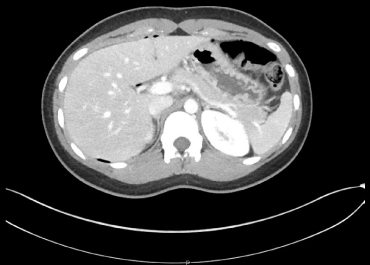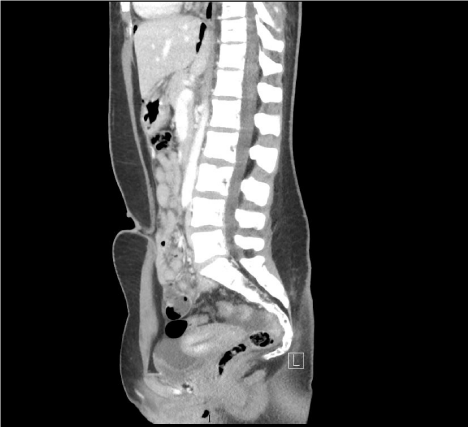Case Report
Valentino’s Syndrome: A Life-Threatening Mimic of Acute Appendicitis
Andrea Austin*
Department of Emergency Medicine, Naval Medical Center San Diego, USA
*Corresponding author: Andrea Austin, Department of Emergency Medicine, Naval Medical Center San Diego, 34800 Bob Wilson Dr, San Diego, CA 92134, USA
Published: 25 Aug 2016
Cite this article as: Andrea Austin. Valentino’s Syndrome:
A Life-Threatening Mimic of Acute
Appendicitis. Ann Clin Case Rep. 2016;
1: 1100.
Abstract
Perforated ulcers are a rare cause of abdominal pain, and may not be considered when pain is
localized to the right lower quadrant (RLQ). This case highlights an unusual presentation of a
perforated duodenal ulcer that presented with RLQ pain, which has been described as Valentino’s
Syndrome. Valentino’s Syndrome occurs when gastric or duodenal fluids collect in the right
paracolic gutter causing focal peritonitis and RLQ pain. This case highlights that perforated ulcers,
while an uncommon cause of RLQ pain, must remain on the differential of any patient that has an
abdominal examination consistent with peritonitis.
Keywords: Valentino’s syndrome; Acute appendicitis
Introduction
Approximately 6 million people in the United States have Peptic Ulcer Disease (PUD) with and annual direct cost estimate of $3.1 billion [1]. Helicobactor pylori infection and nonsteroidal antiinflammatory drug (NSAID) use are considered the two main causes. With improved understanding of the pathogenesis of PUD and improved treatment with antibiotics, proton pump inhibitors (PPIs), avoidance of NSAIDs and advanced endoscopy techniques, the incidence of complications from PUD requiring surgical intervention has decreased to approximately 11% [2]. While a rare event, ulcer perforation is associated with high mortality at 10.6%, and Emergency Physicians must remain vigilant [2]. This case highlights Valentino’s Syndrome, in which the patient presents with pain in the right lower quadrant of the abdomen due to perforation of a duodenal ulcer through the retroperitoneum [3,4,5].
Case Presentation
An eighteen-year-old woman presented to the Emergency Department with a one-day history
of right lower quadrant pain (RLQ). She described the pain as constant with an acute worsening
approximately three hours prior to arrival. The pain was sharp, 10/10 in intensity, and associated
with diaphoresis, nausea, vomiting, and anorexia. She reported taking Ibuprofen for her symptoms,
which provided little relief. She denied a history of dysuria, change in vaginal discharge, or being
sexually active. She was seen by her primary care physician twelve days prior with similar
complaints, where she was diagnosed with gastritis and prescribed Ranitidine 150 mg twice daily
and Ondansetron 4mg as needed for her symptoms.
On physical exam the patient’s vital signs were temperature 98.0°F, pulse 85, blood pressure
128/72, respiratory rate 18, and pulse oximetry 98% on room air. She was well-nourished but in
obvious distress from pain. Abdominal examination revealed tenderness over McBurney’s point
with focal peritonitis. Pelvic exam was unremarkable, with normal discharge and without cervical
motion tenderness or adnexal masses or tenderness.
Laboratory data was remarkable for a negative urine HCG. Urinalysis showed small leukocyte
esterase, but was nitrite negative and without hematuria or pyuria on microscopic analysis. Her
white blood cell count was 6,200 mcl and the remainder of her complete blood count and chemistry
panel were normal. Serum lactate was 0.96 mEq/L. Liver function tests showed an elevated LDH of
519 U/L, normal bilirubin and transaminases. Lipase was elevated at 87 U/L.
The time course of symptoms and the degree of distress initially led the Emergency Physician
to consider ovarian torsion, but pelvic examination and bimanual examination were normal, thus
a CT of the abdomen pelvis was ordered. The study was protocol for appendicitis (intravenous
contrast only). This study revealed pneumoperitoneum centered within the greater sac of the upper anterior abdomen and free fluid in the pelvis (Figures 1 and 2). This was favored to be secondary to a perforated duodenal ulcer and
General Surgery was emergently consulted. Rectal examination was
then performed, which demonstrated brown Guaiac negative stool.
The patient was admitted to the General Surgery service and
underwent an exploratory laparoscopy. She was found to have a
small, perforated ulcer in the first portion of her duodenum which
was repaired with a tongue of omentum, known as a Graham patch
[7]. Her postoperative course was uneventful. Serologic testing for
Helicobactor pylori antibody was significantly elevated at 2.8, U/ml,
indicating an active infection, and her gastrin level was normal. She
was treated for Helicobactor pylori with Amoxicillin/Clarithromycin/
Bismuth and was discharged on postoperative day three. Four
weeks later, upon completion of triple therapy, she underwent an
upper endoscopy, which showed chronic gastritis. Biopsies with
immunohistochemical staining and Campylobacter-like Organism
test were negative for Helicobactor pylori, indicating eradication of
disease.
Figure 1
Discussion
Valentino’s Syndrome occurs when gastric or duodenal fluids
collect in the right paracolic gutter causing focal peritonitis and RLQ
pain [3-5]. The syndrome is named after the 1920’s silent film star
Rudolph Valentino. In 1926, Valentino collapsed in a New York City
hotel and underwent surgery for presumed appendicitis at New York
Polytechnic Hospital. At the time he was found to have a perforated
ulcer. Postoperatively, he developed peritonitis, multiple organ
system dysfunction and died several days later [8]. His case gained
significant notoriety due to his fame at the time, and has since become
a cautionary tale to medical students and residents.
Gastric and duodenal ulcers are often collectively referred to as
PUD because of the similarity in their pathogenesis and treatment.
Helicobactor pylori and NSAIDs contribute the most to PUD.
Complications from PUD include hemorrhage, obstruction, cancer,
and perforation. A better understanding of the risk factors for PUD
has led to a significant decrease in complications of the disease.
Total admissions for PUD have decreased by almost 30% since the
1990’s [2]. The percentage of patients who require emergent surgery
for complicated disease has decreased, to approximately 11% [2].
Perforation has the highest mortality rate of any complication of
ulcer disease, approaching 15% [2]. Despite a decrease in reported
ulcer-related mortality, from 3.9% in 1993 to 2.7% in 2006, over 4,000
estimated deaths are caused by PUD each year.Perforation of an anterior duodenal ulcer allows for free
communication of duodenal and gastric contents into the peritoneal
cavity. These contents will collect in dependent portions of the
peritoneum, which is often the RLQ [3]. If the patient seeks medical
attention early in the course of the disease, he or she may have
poorly localized pain. Localized pain to the RLQ can mimic acute
appendicitis so closely that surgical exploration without imaging has
lead to the diagnosis being made intra-operatively [3]. As time passes,
this can progress to focal tenderness, as in this case, or to generalized
peritonitis. Initial imaging other than CT may demonstrate free fluid
around a normal appendix on ultrasound and free air around the
kidney or “veiled kidney sign” on abdominal radiographs [9]. This
patient was hemodynamically stable with focal peritonitis consistent
with a surgical abdomen with the diagnosis made on CT imaging.
Definitive treatment for a perforated duodenal ulcer is surgical.
This patient underwent a laparoscopic Graham patch repair and
had an uneventful postoperative course. According to primary care
notes, she reported several weeks of abdominal pain, likely a result
of gastritis/PUD, presumably from her Helicobactor pylori infection.
Treatment with NSAIDs may have exacerbated her disease, leading
to her complication of perforation. Given her age, Zollinger-Ellison
Syndrome, a Gastrin-secreting tumor, most commonly found in the
exocrine pancreas, was also on the differential. However, a serum
gastrin level was obtained which was normal, effectively ruling out
this disease.
Figure 2
Conclusion
While relatively rare, especially in young people, perforated gastric and duodenal ulcers have a high morbidity and mortality. Air and liquid from perforated viscous can track to various locations in the abdomen. Thus, in any patient with a peritoneal exam, regardless of the location of this pain, perforated ulcer should remain on the differential.
References
- Sandler RS, Everhart JE, Donowitz M, Adams E, Cronin K, Goodman C. The burden of selected digestive diseases in the United States. Gastroenterology. 2002; 122: 1500–1511.
- Wang YR, Richter JE, Dempsey DT. Trends and outcomes of hospitalizations for peptic ulcer disease in the United States, 1993 to 2006. Ann Surg. 2010; 251: 51-58.
- Mahajan PS, Abdalla MF, Purayil NK. First Report of Preoperative Imaging Diagnosis of a Surgically Confirmed Case of Valentino’s Syndrome. J Clin Imaging. 2014; 4: 28.
- Wijegoonewardene SI, Stein J, Cooke D, Tien A. Valentino's syndrome a perforated peptic ulcer mimicking acute appendicitis. BMJ Case Rep. 2012.
- Hsu CC, Liu YP, Lien WC, Lai TI, Wang HP. A pregnant woman presenting to the ED with Valentino's syndrome. Am J Emerg Med. 2005; 23: 217-218.
- Graham R. The treatment of perforated duodenal ulcers. Surg Gynec Obstet. 1937. 64: 235-238.
- Valentino Loses Battle With Death: Greatest of Screen Lovers Fought Valiantly For Life The Plattsburgh Sentinel. 1926:1.
- Wang HP, Su WC. Images in clinical medicine. Veiled right kidney sign in a patient with Valentino's syndrome. N Engl J Med. 2006; 354: e9.


